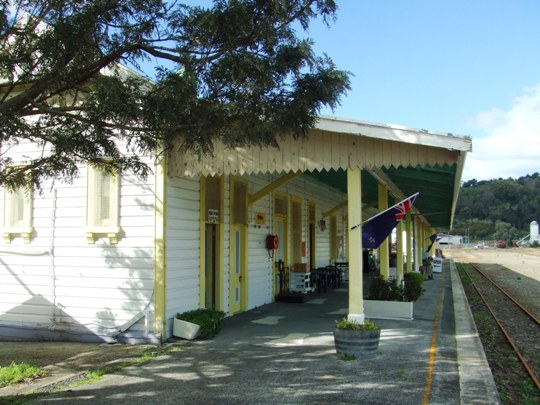A place of thousands of goodbyes and welcomes, the Gisborne Railway Station was erected as part of the rail line optimistically envisaged to link Gisborne with both Napier and Auckland, thereby easing the isolation of the region. Located in the railway yards off Grey Street, Gisborne, it opened in 1902, in conjunction with the completion of the first section of the line between Gisborne and Ormond. Following several years of canvassing by East Coast residents, the Gisborne to Auckland railway line was authorised by the government in 1899. In 1902 the line between Ormond and Gisborne was completed, and fifteen years later the railway line finally reached Moutohora. While various proposals to push the railway through to the Bay of Plenty were mooted, the line was finally abandoned in the 1940s when it was estimated that it would cost £6,000,000 to complete. The line between Gisborne and Napier was completed in 1942, at a total cost of £6,048,511. The Gisborne Railway Station was built by local Gisborne firm Mathieson and Baldock, and it was designed by George Troup, a draughtsman and engineer with, and later head of the architectural branch of New Zealand Railways. Troup designed a series of standard plans, and the Gisborne Railway Station is from Class B which, as J.B. Mahoney writes, 'offered seven choices ranging from an unattended station 44 ft long and containing lobby and ladies' waiting room, to a station 103 ft long and containing lobby and ladies' waiting room, tickets and parcels office, stationmaster, porters and lamp room.' The station is a long timber frame one storey building, with a basically rectangular floor plan. The exterior walls are rusticated timber and the building has a corrugated iron gable roof. A concrete platform runs the length of the station's south side, extending beyond each end. The interior is divided into nine rooms connected by internal doors, including a bathroom at the west end. Many early interior features are intact, including moulded baseboards, dado, cornices and window-frames, with vertical tongue-and-groove lining below the dado and horizontal tongue-and-groove lining above it. In June 1902 the Poverty Bay Herald featured a long report on the festivities associated with the opening of Gisborne's railway station. It is a touching example of optimism and a demonstration of the excitement that came with the railways. 'Gisborne weather favoured the event and the town, which has been splendidly decorated with festoons of flags along the streets, and with splendid arches, looked gayer than it ever had before.' The first train out of the station was greeted by ‘the cheers from several thousand throats, the waving of flags by happy children aboard the cars, and the loud explosion of detonators placed on the line'. By 1939, with the rail link to Napier close to completion, it was decided that the old station building, yard and sidings needed to be completely reorganised and expanded. The station building was moved some distance directly back, expanded and internally rearranged. The work took over a year and left Gisborne with an entirely different station layout, although externally the station was only extended a few metres. There were further internal alterations to the station building in 1944 when a new stationmaster's office was installed. Further shelter was provided in 1950 when the verandah at the redundant Te Karaka station (opened 1905) was shifted to Gisborne and added onto the existing verandah. There were further alterations to the booking office in 1964. The main interior changes in recent years are the remodelled fireplace, and the subdivision of the baggage room by the construction of an internal wall in 1992. The station now houses boutique retail outlets. The Gisborne Railway Station is architecturally significant as an example of the Class B railway station designed by George Troup for New Zealand Railways. While Class B stations do not have the architectural distinction of Troup's individually designed stations, such as those at Dunedin or Blenheim, and were not particularly unique when constructed, they have become important as New Zealand's railway heritage has been gradually demolished. Despite alterations during its lifetime, the Gisborne Railway Station retains a consistent design and has a number of original features. The station is also historically significant as part of the Tairawhiti region's railway network, and a reminder of how important railway connections (between towns in the region, and this region and other places) have been in the economic and social development of Tairawhiti. It also incorporates the verandah of the station at Te Karaka (now demolished). And as a focus of community aspirations, a hub of Gisborne social life in the twentieth century, and a place of thousands of goodbyes and welcomes, Gisborne Railway Station has both social significance and a strong relationship to the community's past.

Location
List Entry Information
Overview
Detailed List Entry
Status
Listed
List Entry Status
Historic Place Category 2
Access
Private/No Public Access
List Number
3531
Date Entered
4th April 1984
Date of Effect
4th April 1984
City/District Council
Gisborne District
Region
Gisborne Region
Extent of List Entry
Extent includes the land described as Lot 1 DP 9549 (RT GS6C/1000) (Railway Station NZGZ 1900 p.1692), Gisborne Land District and the buildings and structures known as Gisborne Railway Station thereon, and its fittings and fixtures.
Legal description
Lot 1 DP 9549 (RT GS6C/1000) (Railway Station NZ Gazette 1900 p. 1692), Gisborne Land District
Stay up to date with Heritage this month
